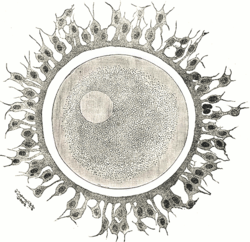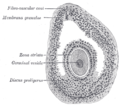Zona pellucida
Thezona pellucida(Latin meaning "transparent zone" ) is the specialized area surroundingmammalianoocytes(eggs). It is also known as an egg coat. The zona pellucida is essential for oocyte growth andfertilization.
| Zona pellucida | |
|---|---|
 Humanovum:The zona pellucida is seen as a thick clear girdle surrounded by the cells of thecorona radiata. | |
| Identifiers | |
| MeSH | D015044 |
| FMA | 18674 |
| Anatomical terminology | |
The zona pellucida is anextracellular matrixthat surrounds theplasma membraneof the egg cell. It helps protect the egg, and has an essential role in fertilization by sperm. It is surrounded by thecorona radiata.The corona is composed of cells that care for the egg when it is emitted from the ovary.[1]
Structure
[edit]The zona pellucida is a translucent matrix of cross-linkedglycoproteinfilaments that surrounds the mammalianoocyteand is 6.5–20 μm thick depending on the species. Its formation, which depends on a conservedzona pellucida-like(ZP) module that mediates the polymerization of egg coat components,[2]is critical to successful fertilization.[3]In non-mammals, it is called thevitelline membraneor vitelline envelope.[4]
Function
[edit]The thick membrane of the zona pellucida functions to only allow species-specific fertilization; to preventpolyspermy,and enable theacrosome reactionfor the successful adhesion and penetration by thesperm cell.It also allows correctembryo developmentand size. The major glycoproteins of the egg coat responsible, are known assperm-binding proteins.[5]
The zona pellucida bindsspermatozoa,and is required to initiate theacrosome reaction.In mice, the zona glycoprotein (ZP3) is responsible for sperm binding, adhering toproteinson the sperm plasma membrane. During the acrosome reaction, a sperm cell releases the DNA contained in theacrosomal vesicleinto the egg. In other species, the process is slightly different and more complicated. Several more zona proteins have been identified.[6][7]
The four major sperm-binding proteins, or sperm-receptors, areZP1,ZP2,ZP3,andZP4.They bind tocapacitated spermatozoaand induce theacrosome reaction.Successfulfertilizationdepends on the ability of sperm to penetrate theextracellular matrixof the zona pellucida that surrounds the egg.[citation needed] In the mouse:
- ZP3allows species-specific sperm binding
- ZP2mediates subsequent sperm binding
- ZP1cross-links ZP2 and ZP3.
In humans, five days after fertilization, theblastocystperformszona hatching;the zona pellucida degenerates and decomposes, to be replaced by the underlying layer oftrophoblasticcells.[citation needed]
Immunocontraception
[edit]ZP module-containing glycoproteinsZP1,ZP2,ZP3andZP4are targets forimmunocontraceptionin mammals.[citation needed]
In non-mammals, the zona pellucida is called thevitelline membraneor envelope, and thevitelline envelopeininsects,and plays an important role in preventing cross-breeding of different species, especially in species such asfishthat fertilize outside of the body.[citation needed]
The zona pellucida is commonly used to control wildlife population problems by immunocontraception. When the zona pellucida of one animal species is injected into the bloodstream of another, it results in sterility of the second species due toimmune response.This effect can be temporary or permanent, depending on the method used. InNew Jersey,immunocontraception usingporcine zona pellucidahas been trialled for the control ofdeer.[8]
Additional images
[edit]-
First stages of segmentation of a mammalianovum
-
Section of vesicular ovarian follicle of a cat, x 50
-
The initial stages ofhuman embryogenesis
References
[edit]- ^Gilbert, Scott (2013).Developmental Biology.Sinauer Associates Inc. p. 123.ISBN9781605351926.
- ^Jovine L, Qi H, Williams Z, Litscher E, de Sanctis D, Wassarman PM (2002). "The ZP domain is a conserved module for polymerization of extracellular proteins".Nat. Cell Biol.4(6): 457–461.doi:10.1038/ncb802.PMID12021773.S2CID11575790.
- ^Gupta, SK; et al. (September 2012). "Mammalian zona pellucida glycoproteins: structure and function during fertilization".Cell and Tissue Research.349(3): 665–78.doi:10.1007/s00441-011-1319-y.PMID22298023.S2CID16174953.
- ^Monné, M; Jovine, L (October 2011)."A structural view of egg coat architecture and function in fertilization".Biology of Reproduction.85(4): 661–9.doi:10.1095/biolreprod.111.092098.hdl:11563/21648.PMID21715714.
- ^Gupta, SK; Bansal, P; Ganguly, A; Bhandari, B; Chakrabarti, K (December 2009)."Human zona pellucida glycoproteins: functional relevance during fertilization".Journal of Reproductive Immunology.83(1–2): 50–5.doi:10.1016/j.jri.2009.07.008.PMID19850354.
- ^Conner, SJ; Hughes, DC (2003)."Analysis of fish ZP1/ZPB homologous genes--evidence for both genome duplication and species-specific amplification models of evolution".Reproduction.126(3): 347–52.doi:10.1530/rep.0.1260347.PMID12968942.
- ^Conner, S.J.; Lefièvre, L; Hughes, DC; Barratt, CL (2005)."Cracking the egg: Increased complexity in the zona pellucida".Human Reproduction.20(5): 1148–52.doi:10.1093/humrep/deh835.PMID15760956.
- ^"Community-Based Deer Management".New Jersey Department of Environmental Protection. 24 September 2014.Retrieved8 July2015.
Further reading
[edit]- Bork, Peer; Sander, Chris (1992)."A large domain common to sperm receptors (Zp2 and Zp3) and TGF-β type III receptor".FEBS Letters.300(3): 237–40.doi:10.1016/0014-5793(92)80853-9.PMID1313375.
- Oehninger, Sergio (2003)."Biochemical and functional characterization of the human zona pellucida".Reproductive BioMedicine Online.7(6): 641–8.doi:10.1016/S1472-6483(10)62086-X.PMID14748962.
- Boja, E. S.; Hoodbhoy, T; Fales, HM; Dean, J (2003)."Structural Characterization of Native Mouse Zona Pellucida Proteins Using Mass Spectrometry".Journal of Biological Chemistry.278(36): 34189–202.doi:10.1074/jbc.M304026200.PMID12799386.
- Bagnell C (2005). "Animal Reproduction". Rutgers University Department of Animal Sciences.[verification needed]
- Jovine, Luca; Darie, Costel C.; Litscher, Eveline S.; Wassarman, Paul M. (2005). "Zona Pellucida Domain Proteins".Annual Review of Biochemistry.74:83–114.doi:10.1146/annurev.biochem.74.082803.133039.PMID15952882.
- Monné, Magnus; Han, Ling; Jovine, Luca (2006). "Tracking Down the ZP Domain: From the Mammalian Zona Pellucida to the Molluscan Vitelline Envelope".Seminars in Reproductive Medicine.24(4): 204–16.doi:10.1055/s-2006-948550.hdl:11563/8929.PMID16944418.
- Wassarman, P. M. (2008)."Zona Pellucida Glycoproteins".Journal of Biological Chemistry.283(36): 24285–9.doi:10.1074/jbc.R800027200.PMC2528931.PMID18539589.
- Wassarman, Paul M.; Litscher, Eveline S. (2008)."Mammalian fertilization:the eggs multifunctional zona pellucida".The International Journal of Developmental Biology.52(5–6): 665–76.doi:10.1387/ijdb.072524pw.PMID18649280.
- Monné, Magnus; Han, Ling; Schwend, Thomas; Burendahl, Sofia; Jovine, Luca (2008). "Crystal structure of the ZP-N domain of ZP3 reveals the core fold of animal egg coats".Nature.456(7222): 653–7.Bibcode:2008Natur.456..653M.doi:10.1038/nature07599.hdl:11563/8930.PMID19052627.S2CID4430083.
- Han, Ling; Monné, Magnus; Okumura, Hiroki; Schwend, Thomas; Cherry, Amy L.; Flot, David; Matsuda, Tsukasa; Jovine, Luca (2010)."Insights into Egg Coat Assembly and Egg-Sperm Interaction from the X-Ray Structure of Full-Length ZP3".Cell.143(3): 404–15.doi:10.1016/j.cell.2010.09.041.hdl:11563/8931.PMID20970175.S2CID18583237.
External links
[edit]- Histology image: 18404loa– Histology Learning System at Boston University - "Female Reproductive System: ovary, cumulus oophorus"
- Histology image: 14805loa– Histology Learning System at Boston University - "Female Reproductive System: ovary, multilaminar primary follicle"
- Anatomy photo: Reproductive/mammal/ovary2/ovary7- Comparative Organology at University of California, Davis - "Mammal, canine ovary (LM, High)"
- Image at um.edu.mt
- Image at um.edu.mt



